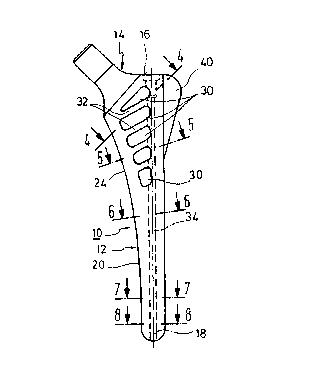Some of the information on this Web page has been provided by external sources. The Government of Canada is not responsible for the accuracy, reliability or currency of the information supplied by external sources. Users wishing to rely upon this information should consult directly with the source of the information. Content provided by external sources is not subject to official languages, privacy and accessibility requirements.
Any discrepancies in the text and image of the Claims and Abstract are due to differing posting times. Text of the Claims and Abstract are posted:
| (12) Patent: | (11) CA 2089236 |
|---|---|
| (54) English Title: | FEMORAL MEMBER OF A HIP JOINT ENDOPROSTHESIS |
| (54) French Title: | MEMBRE FEMORAL D'UNE PROTHESE DE L'ARTICULATION DE LA HANCHE |
| Status: | Expired and beyond the Period of Reversal |
| (51) International Patent Classification (IPC): |
|
|---|---|
| (72) Inventors : |
|
| (73) Owners : |
|
| (71) Applicants : |
|
| (74) Agent: | SMART & BIGGAR LP |
| (74) Associate agent: | |
| (45) Issued: | 1999-06-01 |
| (22) Filed Date: | 1993-02-10 |
| (41) Open to Public Inspection: | 1993-08-12 |
| Examination requested: | 1994-06-24 |
| Availability of licence: | N/A |
| Dedicated to the Public: | N/A |
| (25) Language of filing: | English |
| Patent Cooperation Treaty (PCT): | No |
|---|
| (30) Application Priority Data: | ||||||
|---|---|---|---|---|---|---|
|
A femoral member of a hip joint endoprosthesis, comprising
a shaft having a medial and lateral side which both are
arcuately rounded in cross-section and having a proximal
portion which is provided with openings connecting the
dorsal side with the ventral side, wherein the diameter of
the openings normal with the respect to the shaft axis
decreases from proximal to distal, whereby the distal
shaft portion is formed approximately straight, that at
least the openings adjacent the proximal shaft end are
formed as approximately parallel elongated holes, which
longer axis extends under an angle to the axis of the
distal shaft portion approximately vertical with respect
to the medial side proximally slightly curved..
Note: Claims are shown in the official language in which they were submitted.
Note: Descriptions are shown in the official language in which they were submitted.

2024-08-01:As part of the Next Generation Patents (NGP) transition, the Canadian Patents Database (CPD) now contains a more detailed Event History, which replicates the Event Log of our new back-office solution.
Please note that "Inactive:" events refers to events no longer in use in our new back-office solution.
For a clearer understanding of the status of the application/patent presented on this page, the site Disclaimer , as well as the definitions for Patent , Event History , Maintenance Fee and Payment History should be consulted.
| Description | Date |
|---|---|
| Inactive: IPC from MCD | 2006-03-11 |
| Time Limit for Reversal Expired | 2003-02-10 |
| Letter Sent | 2002-02-11 |
| Inactive: Late MF processed | 2001-06-20 |
| Letter Sent | 2001-02-12 |
| Grant by Issuance | 1999-06-01 |
| Inactive: Cover page published | 1999-05-31 |
| Inactive: Final fee received | 1999-03-01 |
| Pre-grant | 1999-03-01 |
| Notice of Allowance is Issued | 1999-01-15 |
| Letter Sent | 1999-01-15 |
| Notice of Allowance is Issued | 1999-01-15 |
| Inactive: Status info is complete as of Log entry date | 1999-01-11 |
| Inactive: Application prosecuted on TS as of Log entry date | 1999-01-11 |
| Inactive: Approved for allowance (AFA) | 1998-11-16 |
| All Requirements for Examination Determined Compliant | 1994-06-24 |
| Request for Examination Requirements Determined Compliant | 1994-06-24 |
| Application Published (Open to Public Inspection) | 1993-08-12 |
There is no abandonment history.
The last payment was received on 1999-01-28
Note : If the full payment has not been received on or before the date indicated, a further fee may be required which may be one of the following
Patent fees are adjusted on the 1st of January every year. The amounts above are the current amounts if received by December 31 of the current year.
Please refer to the CIPO
Patent Fees
web page to see all current fee amounts.
| Fee Type | Anniversary Year | Due Date | Paid Date |
|---|---|---|---|
| MF (application, 5th anniv.) - standard | 05 | 1998-02-10 | 1998-01-21 |
| Registration of a document | 1998-03-14 | ||
| MF (application, 6th anniv.) - standard | 06 | 1999-02-10 | 1999-01-28 |
| Final fee - standard | 1999-03-01 | ||
| MF (patent, 7th anniv.) - standard | 2000-02-10 | 2000-01-18 | |
| Reversal of deemed expiry | 2001-02-12 | 2001-06-20 | |
| MF (patent, 8th anniv.) - standard | 2001-02-12 | 2001-06-20 |
Note: Records showing the ownership history in alphabetical order.
| Current Owners on Record |
|---|
| MERCK PATENT GMBH |
| Past Owners on Record |
|---|
| HANS ERICH HARDER |
| KARL OBERSTEINER |
| VILMOS VECSEI |